Related Research Articles

Pembridge is a village and civil parish in Arrow valley in Herefordshire, England. The village is on the A44 road about 6 miles (10 km) east of Kington and 7 miles (11 km) west of Leominster. The civil parish includes the hamlets of Bearwood, Lower Bearwood, Lower Broxwood, Marston, Moorcot and Weston. The 2011 Census recorded the parish population as 1,056.
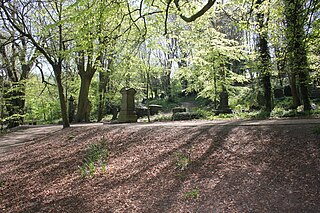
The General Cemetery in the City of Sheffield, England opened in 1836 and closed for burial in 1978. It was the principal cemetery in Victorian Sheffield with over 87,000 burials. Today it is a listed Landscape on the English Heritage National Register of Historic Parks and Gardens. It is also a Local Nature Reserve. It is owned by the City of Sheffield and managed on behalf of the city by a local community group, the Sheffield General Cemetery Trust.

Ranmoor is a suburb of the City of Sheffield, England. It is an affluent suburb in the Fulwood ward of the city. It mostly developed in the late 19th and early 20th centuries, and it features a number of large houses that were built for the city's steel magnates, as well as, most notably, a large church, St John's. This church was opened 24 April 1879 but was almost entirely destroyed by fire on 2 January 1887. All that survived from the original church was the tower and spire, which still stands today. A new building was built and the church reopened on 9 September 1888; it is now a Grade II* listed building. A row of early 19th century buildings near the church includes the Bull's Head and Ranmoor Inn public houses.

Carbrook Hall is a historic house in Sheffield, England. Located in the Carbrook district of the city, the original building was owned by the Blunt family from 1176. This was rebuilt in 1462, and was bought by Thomas Bright in the late 16th century. His descendant, John Bright, was an active Parliamentarian during the English Civil War, and the building was used as a Roundhead meeting place during the siege of Sheffield Castle. The Bright family continued to play a prominent role in Sheffield, however, by the end of the eighteenth century the gentry line had died out. Writing in 1819 Joseph Hunter, a minister and antiquarian from Sheffield wrote "the hall at Carbrook...has been deserted by its owners for more than a century but still retains traces of its former consequence".
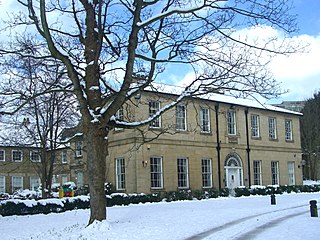
Broom Hall is a historic house in the City of Sheffield, England that gives its name to the surrounding Broomhall district of the city. The earliest part of the house is timber-framed; it has been tree-ring dated to c1498, and was built by the de Wickersley family, whose ancestral home was at Wickersley. The de Wickersley family descended from Richard FitzTurgis, who co-founded Roche Abbey in South Yorkshire. The de Wickersley family later dropped their Norman name (FitzTurgis) in favour of the village they controlled.

Brightside is an industrial area of Sheffield, South Yorkshire, England lying on a hill north of Attercliffe and the River Don.
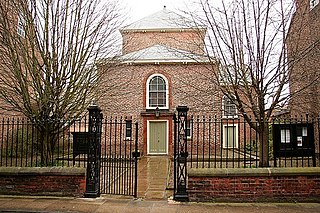
York Unitarian Chapel is a building on St. Saviourgate, York, England. It is a member of the General Assembly of Unitarian and Free Christian Churches, the umbrella organisation for British Unitarians.

The Globe Works are a former cutlery factory situated in the City of Sheffield, South Yorkshire, England on Penistone Road in the suburb of Neepsend. The Works are a Grade II* Listed Building which in the late 1980s were renovated to provide modern office space. It is part of the Kelham Island Conservation Area.

Cornish Place is a listed building situated in the Neepsend area of the City of Sheffield. The building was formerly the factory of James Dixon & Sons, a Britannia metal, Sheffield plate and Cutlery manufacturer. In the late 1990s the disused building was cleaned and converted into apartments, it is regarded as the most impressive cutlery works that still stands in Sheffield and rivals the cotton mills of Lancashire and the West Riding in terms of architectural quality and heritage. The east and west ranges of the structure are the most spectacular, with Grade II* listed classification, while the rest of the works receive the lower Grade II category. The "Cornish" in the buildings name is thought to derive from the manufacture of Britannia metal which is made up of 93% tin which came from Cornwall.

Wright's Almshouses is a terrace of six former almshouses now located on Beam Street in Nantwich, Cheshire, England. The building was originally erected at the junction of Hospital Street and London Road in 1638 by Edmund Wright, Lord Mayor of London in 1640–41, and is listed at grade II*. The low red-brick terrace has stone dressings and a central stone panel with arms. The adjacent stone archway of 1667, which Nikolaus Pevsner describes as the "best" feature of the almshouses, is also listed separately at grade II*, together with its associated wall.

Butchers Wheel or Butcher Works is a former cutlery and tool factory in Sheffield, South Yorkshire. The last of the manufacturing tenants left in 2004. The building is a listed historic site, and is now used for residential and retail purposes.

The Beehive Works are a purpose-built cutlery works located on Milton Street in the Devonshire Quarter area of Sheffield city centre. The works were built in stages in the second half of the 19th century and are designated as a Grade II* listed building with English Heritage stating that they are of special architectural and historic interest as an examples of buildings associated with Sheffield's metal manufacturing and metal working trades. The works stand adjacent to the Taylor's Eye Witness Works and together they make Milton Street one of the best places to gain an impression of Sheffield’s former cutlery industry.

35 Well Meadow Street is the site of a house, attached workshops, courtyard complex and a crucible furnace. It is located in the St Vincent's Quarter of the City of Sheffield in England, it is also part of the Well Meadow Conservation Area. The buildings and furnace are grade II* listed buildings because of their importance as part of Sheffield’s industrial heritage and it is regarded as, “One of the most significant of the city’s 19th century industrial monuments”. It has now been converted into residences.

Fulwood Hall, is an English country house situated on Harrison Lane in the suburb of Fulwood in Sheffield, England. It is a Grade II listed building. The hall stands in a lofty position on the north side of the Mayfield Valley at a height of 270 metres. The hall is referred to as Fullwood Hall on old maps and the gate to the hall uses this spelling with two Ls.
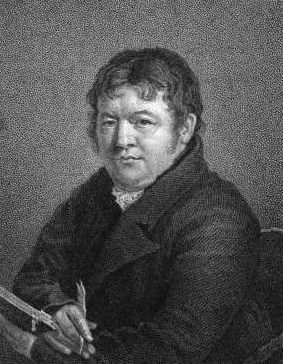
Joseph Ivimey (1773–1834) was an English Particular Baptist minister and historian.

The Hospital of St Mary Magdalene is a former Catholic religious complex in Glastonbury, Somerset, England. It built around 1310 by the Benedictine monks of Glastonbury Abbey. The hospital is a Grade II* listed building, and a portion has been scheduled as an ancient monument.
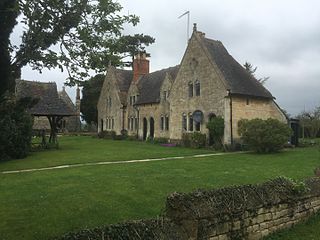
The Yorke Almshouses, Nos. 14–17 Church Row, Forthampton, Gloucestershire, England, are a range of four almshouses designed by the architect William Burges in 1865. The block is a Grade II listed building and the almshouses remain private residences.

Lady Anne House is a former almshouse, now a hotel, in York, in England.

Lady Hewley's Almshouses are a historic building in the city centre of York, in England.
References
- ↑ Ivimey 1823, p. 387.
- 1 2 Waters 1891, p. 51.
- 1 2 Leader 1905.
- ↑ Disney 1808, p. 46.
- ↑ BL 1896.
- ↑ Historic England & 1255159.
- 1 2 Historic England & 1058980.
- ↑ Historic England & 1270722.
- ↑ Historic England & 1344935.